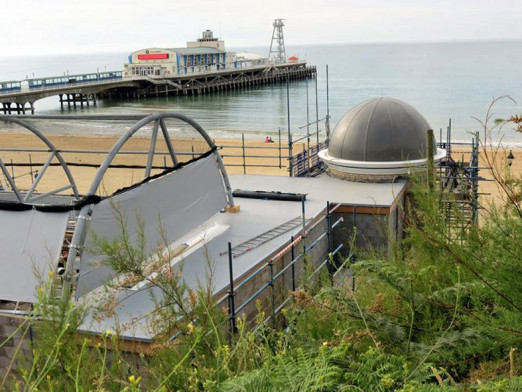SIG Design & Technology’s technical manager Steve Cleminson looks at why you should insist the whole roof specification is installed by a roofing professional and not broken up into its component parts.
Three problem projects of a similar nature have come into the office in the last three weeks. They are all domestic projects, they are all single ply roofing membrane, and they were all reported to have been leaking due to a failure in the roofing membrane.
The client reported that wet patches were appearing on the plasterboard ceiling, and on inspection the membrane appears to be blistering. So, SIG Design & Technology carry out an inspection.
The Roof Inspection
The Armourplan membrane is opened to reveal the plywood deck. The whole area of plywood boarding appears damp, with the top layers of the plywood beginning to delaminate. This project is less than a year since completion.
When a section of the plywood is removed it reveals 100mm foil faced insulation, laid directly over joists.
When a section of the insulation is removed, it exposes a 250mm void between the insulation and the ceiling plasterboard. There is no evidence of any vapour control layer (VCL) within the roof buildup.
Why would there be no VCL? This roofing contractor is a professional. He knows there should be a VCL.
The Roof Installation
It turns out the roofing contractor did not install the whole roof, just the membrane.
The main contractor had fitted the insulation and boarding, and informed the roofing contractor that the build-up had been installed correctly and that all he needed to do was to install the Armourplan membrane on top.
The roofing contractor has his doubts, but he needs the work and takes the contractor’s word for it. Perhaps he assumes the main contractor knows as much about roof build ups as he does. After all, he’s a professional.
Checking the written specification for the roof confirms that it included a VCL, but the main contractor on the project had decided that they could meet the specification themselves except for the waterproofing membrane, and thereby save on the cost of paying the roofing contractor to supply and install the whole system. This might save him a few pounds per square meter of roof, but it all affects the bottom line.
The main contractor purchases the insulation and boarding, but fails to put in the vapour control layer. He tells the roofing contractor all the lower layers were put in correctly, and the roofing contractor sees what looks like a completed deck and installs the membrane.
The diagram shown demonstrates the build-up as installed – an insulation board was placed directly on the joists with a separate plywood layer on top of this insulation. A composite product exists which you can install like this, but it has specific requirements including a considerable number of specialised fixings and sealant requirements to ensure correct vapour control movement. In this case, the contractor bought the insulation and installed plywood on top with no VCL.
What Happens When You Don’t Build the Roof Correctly
To control the movement of water vapour in the roof build-up, a Vapour Control Layer should have been installed, with sealed laps, and sealed back to the structure.
In the three projects we have seen, condensation occurred exactly below the membrane, either on the plywood or the insulation (depending on the build-up used), producing visible blistering and wet patches inside. If left the deck and insulation would gradually get wetter and wetter, even though the membrane itself was correctly installed.
The roof is not leaking, it’s got interstitial condensation.
For the sake of saving a very small margin, as little as £1 per square metre, the decision to ‘Do it Yourself’ results in the complete removal, skippage and replacement of all layers and associated delays, disruption and effect on the critical path of your project. The vast majority of the products used will have to be scrapped and replaced.
By not leaving the roof build-up with the expert roofing contractor, the main contractor has left themselves with a very expensive problem. That £40 saving has now cost you £4000.
A False Economy
The contractor may think that they can ‘do the easy bits’ but if they aren’t carried out by someone who knows about compatibility, system performance and compliance, something may well left out which can be very costly. It’s a bit like telling the surgeon you only need him to do the “heart bypass” part of the operation, as you’ve got a mate from down the pub with a sharp knife and a sewing kit from a hotel room that can do the chest opening and closing a lot cheaper.
Professional roofing contractors install roofs in a professional way. For instance, as the contractor works, they must create a night joint in an incomplete roof to avoid trapping moisture into the system if it rains overnight. Even if a main contractor does install the VCL and insulation correctly, because of the potential time gap between these elements being completed and the roofer turning up to install the waterproofing there would be a huge risk of getting entrapped moisture – with significant consequences.
It isn’t just installing it correctly either. The main contractor may not have chosen the right type of insulation – wall not roof (a not uncommon occurrence), EPS not XPS, foil faced not tissue faced (perhaps because it’s thinner). A single change in letter can mean a whole job fails.
If there is a legitimate reason to change the specification, this is perfectly possible, and a lot less costly than stripping the roof. You can redesign with a new product, but you must take into account the interaction of each layer with the prior and subsequent ones, and amend the U-value and interstitial condensation risk analysis calculations, for example.
What Can We Learn from These Mistakes?
If you’re an architect working on small scale projects, here are some points to consider.
- Encourage a culture of professional respect on site, and choose contractors who behave professionally. Advise your client to do the same – they will pay in the end for the corner cutting.
- Insist the whole roof specification is installed by an accredited contractor and not broken up into its component parts. Roofing professionals are roofing professionals.
- Be confident your manufacturer or supplier is inspecting the roof installation so they can issue a guarantee on completion. This is part of our holistic service.
- Look out for situations on a relatively new flat roof suffering from blisters and damp patches below, where the roof may be leaking but in fact is interstitial condensation. Perhaps you have been victim of a cut-price heart operation!







